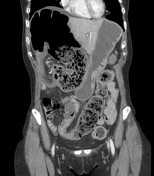Pericaecal hernia
Updates to Article Attributes
Pericaecal hernia (alternative plural: herniae) is a rare type of internal hernia.
Epidemiology
It accounts for only 6-13% of internal abdominal hernias.
Clinical presentation
Clinical symptoms are often characterised by episodes of intense lower abdominal pain, like a colicky right lower quadrant pain very similar to the appendiceal pain, often causing confusion.
Pathology
Four subtypes (ileocolic, retrocaecal, ileocaecal, and paracaecal) of herniations occur in the pericaecal fossa (located behind the caecum and ascending colon and is limited by the parietocaecal fold outward and the mesentericocaecal fold inward). It is due to acquired or congenital defects in the caecal mesentery.
Retrocaecal hernia is the most common subtype caused by herniation of ileal loops through a defect in the caecal mesentery and the right paracolic gutter.
Radiographic features
Fluoroscopy
Delayed radiograph series of the small bowel or a barium enema examination may show retrograde opacification of the terminal ileum.
CT
These hernias can often be confidently diagnosed as a cluster of bowel loops (usually ileal) located posteriorly and laterally to the normal caecum, occasionally extending into the right paracolic gutter. In addition, a beaking appearance at the entrance of the hernia, and a dilated afferent small bowel loop and collapsed efferent loop in the transition zone may be seen. There might be evidence of small-bowel obstruction and mass effect displacing the caecum anteriorly and medially.
-<p><strong>Pericaecal hernia</strong> (alternative plural: herniae) is a rare type of <a href="/articles/internal-hernia">internal hernia</a>.</p><h4>Epidemiology</h4><p>It accounts for only 6-13% of internal abdominal hernias.</p><h4>Clinical presentation</h4><p>Clinical symptoms are often characterised by episodes of intense lower abdominal pain, like a colicky right lower quadrant pain very similar to the appendiceal pain, often causing confusion.</p><h4>Pathology</h4><p>Four subtypes (ileocolic, retrocaecal, ileocaecal, and paracaecal) of herniations occur in the pericaecal fossa (located behind the caecum and ascending colon and is limited by the parietocaecal fold outward and the mesentericocaecal fold inward). It is due to acquired or congenital defects in the caecal mesentery.</p><p>Retrocaecal hernia is the most common subtype caused by herniation of ileal loops through a defect in the caecal mesentery and the right paracolic gutter. </p><h4>Radiographic features</h4><h5>Fluoroscopy </h5><p>Delayed radiograph series of the small bowel or a <a title="Double contrast barium enema (overview)" href="/articles/double-contrast-barium-enema-overview">barium enema examination</a> may show retrograde opacification of the terminal ileum.</p><h5>CT</h5><p>These hernias can often be confidently diagnosed as a cluster of bowel loops (usually ileal) located posteriorly and laterally to the normal caecum, occasionally extending into the right paracolic gutter. In addition, a beaking appearance at the entrance of the hernia, and a dilated afferent small bowel loop and collapsed efferent loop in the transition zone may be seen. There might be evidence of small-bowel obstruction and mass effect displacing the caecum anteriorly and medially.</p>- +<p><strong>Pericaecal hernia</strong> (alternative plural: herniae) is a rare type of <a href="/articles/internal-hernia">internal hernia</a>.</p><h4>Epidemiology</h4><p>It accounts for only 6-13% of internal abdominal hernias.</p><h4>Clinical presentation</h4><p>Clinical symptoms are often characterised by episodes of intense lower abdominal pain, like a colicky right lower quadrant pain very similar to the appendiceal pain, often causing confusion.</p><h4>Pathology</h4><p>Four subtypes (ileocolic, retrocaecal, ileocaecal, and paracaecal) of herniations occur in the pericaecal fossa (located behind the caecum and ascending colon and is limited by the parietocaecal fold outward and the mesentericocaecal fold inward). It is due to acquired or congenital defects in the caecal mesentery.</p><p>Retrocaecal hernia is the most common subtype caused by herniation of ileal loops through a defect in the caecal mesentery and the right paracolic gutter. </p><h4>Radiographic features</h4><h5>Fluoroscopy </h5><p>Delayed radiograph series of the small bowel or a <a href="/articles/double-contrast-barium-enema-overview">barium enema examination</a> may show retrograde opacification of the terminal ileum.</p><h5>CT</h5><p>These hernias can often be confidently diagnosed as a cluster of bowel loops (usually ileal) located posteriorly and laterally to the normal caecum, occasionally extending into the right paracolic gutter. In addition, a beaking appearance at the entrance of the hernia, and a dilated afferent small bowel loop and collapsed efferent loop in the transition zone may be seen. There might be evidence of small-bowel obstruction and mass effect displacing the caecum anteriorly and medially.</p>
Image 1 CT (C+ portal venous phase) ( create )








 Unable to process the form. Check for errors and try again.
Unable to process the form. Check for errors and try again.